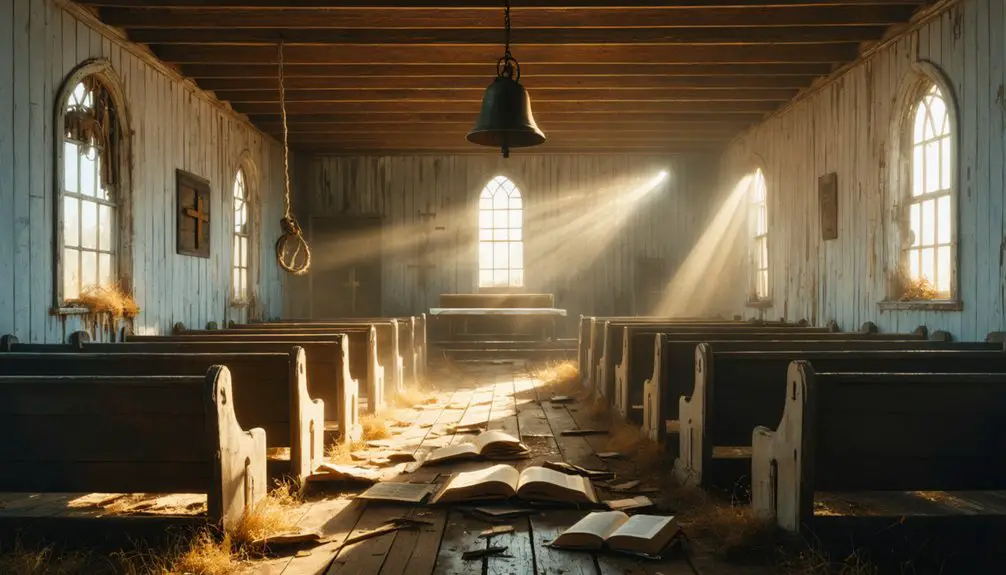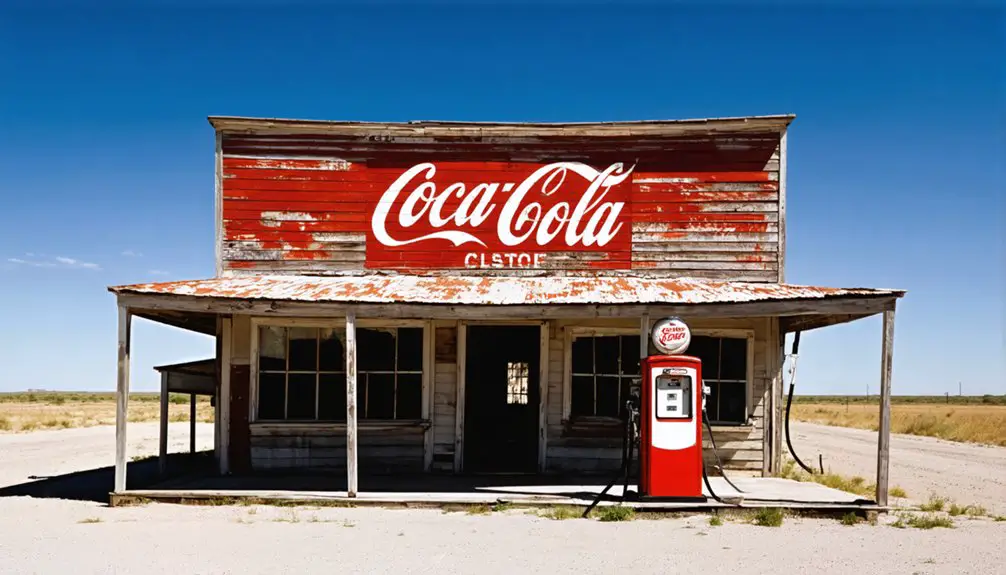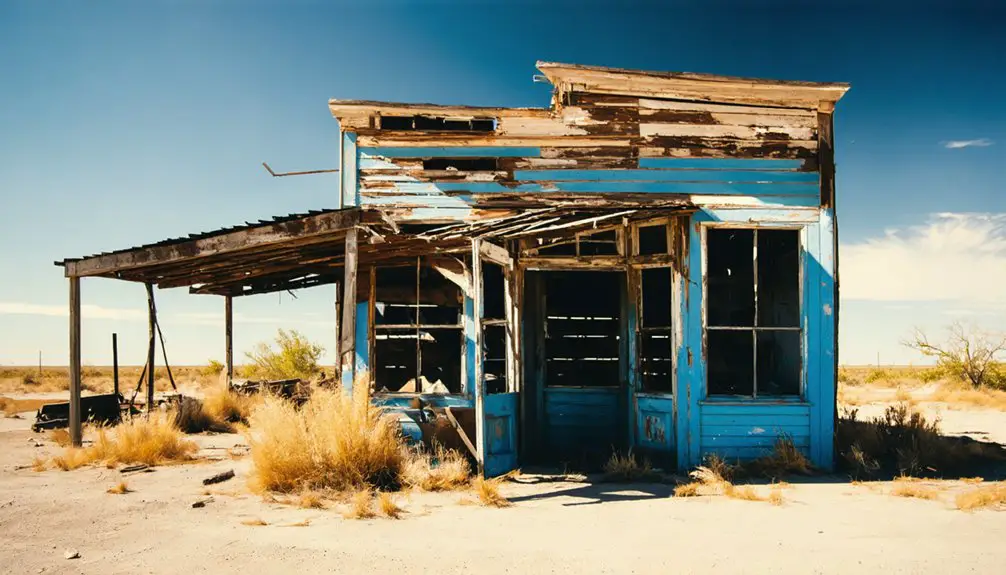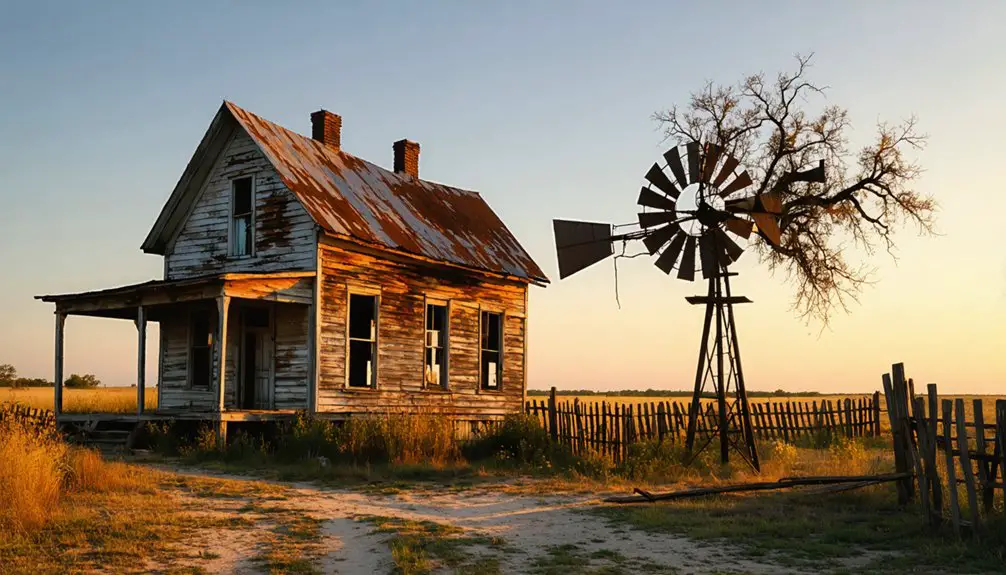You’ll find Becton, Texas tucked away in the state’s windswept plains, where it began as Bledsoe in 1925 along the Panhandle and Santa Fe Railway. This farming community flourished with 150 residents at its peak, boasting three businesses and thriving churches. Today, it’s a semi-abandoned ghost town with weathered buildings and beautiful stained glass windows telling tales of its prosperous past. The scattered foundations and historic markers hold secrets of rural America’s changing landscape.
Key Takeaways
- Becton is a semi-abandoned ghost town in Texas that once thrived with 150 residents during its peak agricultural years.
- Originally named Bledsoe, the town changed its name due to postal confusion and became an agricultural hub along the railway.
- Three churches and businesses supported the community until the 1970s, when declining membership forced religious institutions to close.
- Advanced irrigation systems and railway access transformed Becton into a prosperous farming community specializing in grain sorghum and wheat.
- Today, abandoned churches with stained glass windows and weathered buildings stand as remnants of Becton’s once-vibrant community life.
From Bledsoe to Becton: The Story Behind the Name
When Bledsoe, Texas first sprouted up along the Panhandle and Santa Fe Railway in 1925, nobody could’ve predicted it’d need to change its name.
Small Texas towns along the railways often faced unexpected challenges, including having to completely reinvent their identities.
But that’s exactly what happened when the town discovered another Bledsoe already existed in Texas, causing postal confusion that needed fixing fast.
You might wonder how Becton history took its turn.
Well, a local pioneer named Abner M. Becton would become the town’s namesake when Moody, seeking to establish postal services, proposed the change.
It’s a classic tale of the American frontier, where towns often honored their early settlers.
The name significance runs deep in these parts – you’ll find that many Texas communities chose their identities this way, marking their place in the landscape while tipping their hat to those who helped build it. Like Prairie View Agricultural and Mechanical College, which transitioned from the title of principal to president in 1948, communities often evolved in how they identified themselves. The town’s first postal service was established when E. H. Moody became its inaugural postmaster.
Early Postal Service and Railway Development
As the Texas Republic stretched its wings in 1835, a remarkable postal system took flight under John Rice Jones, the territory’s first postmaster general.
You’d have marveled at those first mail carriers, blazing trails across 379 miles from New Orleans to San Felipe de Austin, connecting isolated frontier communities through sheer determination.
The postal history of Becton reflects the spirit of those early days.
E.H. Moody ran the local post office from his store, serving as a central hub for the community.
When railways finally thundered through Texas, they revolutionized mail delivery, replacing slow-moving stagecoaches with iron horses that could haul larger loads faster.
Railway expansion brought prosperity to small towns like Becton, where the post office became the heartbeat of community life.
Mail carriers could even claim 320-acre land tracts for their service – now that’s what you’d call a special delivery!
By 1851, these essential mail routes operated without any regular steamboat service, relying primarily on wagon trains to maintain vital connections between communities.
Peak Years of Growth and Prosperity
Though modest in size compared to Texas’s booming oil towns, Becton hit its stride in the early 20th century with around 150 hard-working souls calling it home.
You’d find a close-knit community of farmers working the fertile soil, their success fueled by improved irrigation methods and determination. Unlike towns like Best that experienced rapid growth to 3,500 residents during oil booms, Becton maintained steady, sustainable development.
During these peak years, you could feel the economic stability that good crop yields brought to local families. Like the many ghost towns of Texas, Becton’s story became part of the state’s rich historical tapestry. Folks gathered at community buildings, sharing stories and supporting each other through the seasons.
Multi-generational farming families formed the backbone of Becton’s community cohesion, creating lasting bonds through shared work and celebration.
While Becton never grew into a major hub, it maintained enough vigor to support essential services and foster a proud agricultural heritage that defined West Texas living.
Agricultural Legacy and Economic Impact
You’ll find Becton’s rise to prosperity was tightly woven with its agricultural roots, as the installation of irrigation systems transformed once-risky farming into reliable crop production.
Those life-giving water systems helped local farmers expand beyond simple subsistence to grow diverse, profitable crops that supported three thriving businesses by the mid-1930s.
When you look at Becton’s peak years of growth, you’re seeing the direct impact of that farm-to-rail economy that brought 150 residents to this bustling agricultural hub by the mid-1940s.
Local farmers found great success cultivating grain sorghum and wheat as their principal crops.
The town shares its name with Maxwell Becton, who went on to establish the renowned medical equipment company Becton Dickinson in 1897.
Irrigation Shapes Town Growth
While early Texas settlers faced countless challenges, irrigation became the lifeblood that transformed Becton and similar farming communities into thriving agricultural hubs.
You’ll find that the irrigation impact stretched far beyond mere water management – it revolutionized the entire region’s agricultural development.
When farmers banded together to form irrigation districts in the early 1900s, they weren’t just digging ditches; they were building their future. They’d learned from Spanish mission techniques and brought steam-powered innovation to their fields. The introduction of advanced steam engines helped establish sophisticated irrigation systems throughout Texas by the late 1800s.
You could see the transformation as cotton fields flourished, and land values soared.
The cooperative spirit of these irrigation districts didn’t just water the crops – it cultivated tight-knit communities where farmers shared resources and supported each other’s success. These early efforts laid the groundwork for extensive growth, as Texas reached 8.5 million acres of irrigated land by 1974.
Farm-to-Rail Economic Evolution
As Becton’s farming community blossomed in the late 1920s, the arrival of the Fort Worth and Denver Railway transformed this quiet agricultural town into a bustling hub of commerce.
You’d have seen cotton and corn flowing from local farms to distant markets, while freight-related businesses sprouted up along the tracks like spring wildflowers.
The railroad’s significance can’t be overstated – it was the lifeline that kept Becton’s heart beating.
The town’s economic dependency on rail transport meant the difference between prosperity and isolation.
When trains rolled through, they brought more than just mail and supplies; they carried the promise of freedom and connection to the wider world.
But as rail service declined, so did Becton’s fortunes, following the fate of many small Texas farming towns.
Religious Life and Community Bonds

Throughout its vibrant history, Becton’s religious institutions served as the beating heart of community life, with churches acting as more than just places of worship. You’ll find that religious gatherings strengthened community identity through shared experiences, from joyous celebrations to times of mourning.
What started as humble meetings in the schoolhouse blossomed into multiple thriving congregations by the 1920s, including the stalwart Bethany Baptist Church and the enduring Bledsoe Church of Christ.
- Early church services brought neighbors together in the schoolhouse before permanent structures were built.
- Three different denominations coexisted, showing the town’s diverse spiritual fabric.
- Churches hosted life’s major milestones – from baptisms to funerals.
- Even as population declined, these sacred spaces remained powerful symbols of community bonds.
Unfortunately, by the 1970s, declining membership forced several churches to close, marking the end of an era.
Population Changes Through the Decades
When Becton first sprouted up in the 1930s, you’d find just 25 hardy souls calling it home, though they managed to support three businesses, two schools, and a church.
By 1945, you’d see the town flourishing with 150 residents, thanks to farming prosperity and new irrigation methods that brought economic resilience to the area.
Irrigation advancements and agricultural success transformed Becton into a thriving farming community of 150 residents by 1945.
The town’s population stability held steady at about 125 folks through the mid-1970s, but you’d notice the businesses gradually disappearing.
While three churches and a factory kept the community spirit alive in ’78, the loss of essential services began taking its toll.
The Last Operating Businesses

Despite Becton’s dwindling population, you’ll still find a handful of determined businesses keeping the town’s commercial pulse alive.
Ghost town businesses here have shifted from serving locals to embracing tourism impact, with restored historic buildings drawing visitors from far and wide. You’ll see entrepreneurial spirits making the most of Becton’s heritage, turning challenges into opportunities.
- A small restaurant and shop are planned to save locals that grueling 19-mile supply run
- Historic church restoration’s underway to welcome heritage tourists
- Private investors are breathing new life into old storefronts
- Tourism-focused shops and eateries are creating fresh income streams
These resilient businesses are writing Becton’s next chapter, proving that with grit and innovation, even a ghost town can keep its commercial heart beating.
Transportation Evolution and Infrastructure
As the Fort Worth and Denver Railroad laid tracks through Becton in 1928, the town’s destiny became inextricably linked to those steel rails.
The destiny of many Texas towns lay in the steel rails that snaked across the land, binding communities to the rhythms of commerce.
You’d have seen company wagons rolling down dusty streets, horses hauling supplies between the depot and local businesses, and farmers bringing their crops to the railroad switchyards.
Transportation routes were the lifeblood of this small Texas town. From the brick vaults and corrals to the machine shops and lumber offices, every bit of infrastructure revolved around moving goods and people.
But when the railroads changed their service patterns, Becton’s fate was sealed. The economic decline hit hard and fast – without those essential rail connections, the town couldn’t sustain itself.
Like many other Texas communities bypassed by progress, Becton’s once-bustling streets gradually emptied into ghostly silence.
Remnants of a Once-Thriving Town

If you’re visiting Becton today, you’ll find the silent shells of its Baptist and Church of Christ buildings standing as lonely sentinels of a once-bustling community.
The old railroad tracks that brought mail and supplies starting in 1928 still cut through the landscape, though they no longer serve the town’s needs.
While most structures have vanished into time, you can spot scattered foundations and a few weathered buildings that hint at Becton’s prosperous past when it boasted multiple businesses and a thriving population of 150 residents.
Abandoned Churches Stand Silent
The weathered steeples and empty pews of Becton’s abandoned churches tell a poignant story of Texas’s vanishing rural communities.
You’ll find these sacred spaces – once vibrant centers of faith and fellowship – standing as silent sentinels of ghost town history. The abandoned architecture of the Bledsoe Church of Christ (1917) and Becton Baptist Church (1920s) reflects the heart-wrenching exodus that followed World War II, when folks began leaving their farming roots behind.
- Original brick structures still showcase beautiful stained glass windows and medallion wall art
- Church buildings doubled as community gathering spots for births, weddings, and funerals
- Local settlers personally invested in construction, contributing materials and funds
- Some properties maintain “not abandoned” signs, showing the community’s spirit lives on
Railroad Tracks Through Time
Steel rails stretching across the Texas plains tell Becton’s bittersweet tale of boom and bust.
You can still trace the ghostly path where the Fort Worth and Denver Railroad once brought life to this small farming town in 1928. Those tracks changed everything – transforming Becton from a simple mail-stop into a bustling hub of 150 souls.
During the railroad expansion of the 1930s and ’40s, you’d have seen freight cars loaded with crops and supplies, three thriving companies, and a factory humming with activity.
But like many Texas towns caught in time’s ruthless march, economic decline took its toll.
Today, the abandoned rails lie silent, overgrown with weeds – stark reminders of when iron horses thundered through, carrying Becton’s dreams of prosperity across the endless horizon.
Last Buildings Still Standing
Weathered survivors of Becton’s heyday still dot the landscape, their wooden frames and stone foundations standing defiantly against time’s relentless march.
You’ll find these silent sentinels scattered throughout the ghost town, each telling stories of Texas grit and determination. While historic preservation efforts haven’t fully reached Becton’s remaining structures, their early 20th-century architectural styles showcase the practical, utilitarian designs that defined rural Texas living.
- Old homesteads with their simple wooden frames and weathered porches
- Empty commercial buildings where traders once bartered and gossip flowed freely
- Community gathering spots, including church buildings that once echoed with hymns
- Historic markers and cemeteries that refuse to let Becton’s spirit fade away
These buildings might be empty now, but they’re still standing proud, just like the independent folks who built them.
Legacy Among Texas Ghost Towns
Standing among countless Texas ghost towns, Becton’s legacy shines as a poignant reminder of the South Plains’ pioneering spirit.
You’ll find this historic community’s story woven into the fabric of Texas ghost town preservation, where agricultural dreams once flourished before giving way to modern realities.
Like many of its silent neighbors, Becton history tells a tale you’ve heard before – a settlement born of hope and hard work, marked by the names of early settlers like Bledsoe and Becton himself.
While its businesses have vanished and its population has dwindled, the remnants of churches, schools, and weathered buildings stand as proof to the determined souls who carved out a life here.
Today, Becton’s semi-abandoned status reflects a broader pattern of rural Texas communities that time and progress left behind.
Frequently Asked Questions
Are There Any Notable Historical Figures Who Lived in Becton?
You’ll find influential families like the Bectons, including Abner M. Becton who donated land for schools, plus E.H. Moody, your first postmaster, and W.E. Bledsoe, who built your first schoolhouse.
What Natural Disasters or Events Significantly Impacted Becton’s Development?
Like a town blessed by Mother Nature’s gentle hand, you won’t find records of major flooding events or devastating drought impacts that shaped Becton’s story – its challenges came from human factors instead.
Did Becton Have a School System During Its Active Years?
You’ll find Becton’s school history started with a one-room schoolhouse, grew to a brick building by 1924, and made quite an education impact until merging with Idalou’s district in 1936.
What Types of Crops Were Primarily Grown in Becton’s Agricultural Heyday?
You’d find farmers prosperin’ with wheat, corn, and cotton production dominatin’ the fields, while smart crop rotation practices kept the soil rich for oats and sweet potatoes too.
Are There Any Preserved Buildings or Historical Markers in Becton Today?
Like tumbleweeds rolling through time, you won’t find any preserved buildings or historical markers in Becton today. The old schoolhouse and other structures have vanished into prairie dust and memory.
References
- https://www.texasstandard.org/stories/best-texas-the-ghost-town-with-the-worst-reputation/
- https://en.wikipedia.org/wiki/Becton
- https://www.desertedtexas.org/2015/05/benton-texas/
- https://en.wikipedia.org/wiki/List_of_ghost_towns_in_Texas
- https://www.lubbockonline.com/story/news/local/2010/03/29/long-vanished-becton-home-south-plains-pioneer-spirit/15275418007/
- https://www.lubbockonline.com/story/lifestyle/2017/01/21/caprock-chronicles-becton-was-once-thriving-farm-community-lubbock-county/14877835007/
- https://www.texasescapes.com/SouthTexasTowns/Benton-Texas.htm
- https://www.tshaonline.org/handbook/online/articles/hlb17
- https://www.pvamu.edu/president/past-presidents/
- https://www.tshaonline.org/handbook/entries/bledsoe-tx



